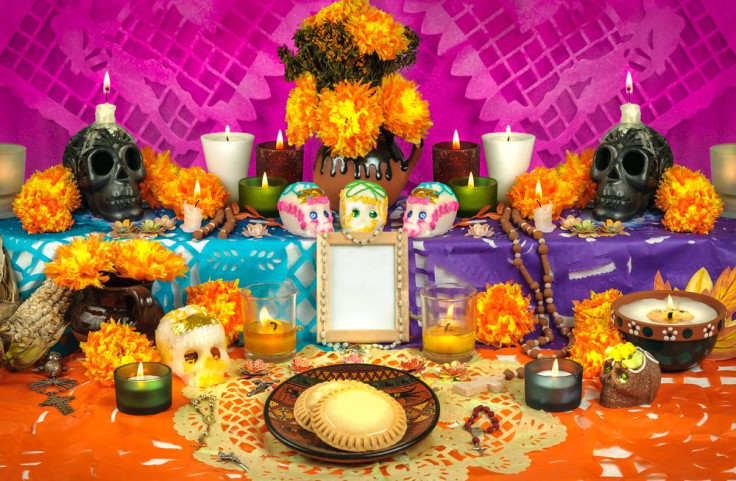
The “Día de los Muertos” tradition focuses on celebrating and remembering friends and family who have passed on to a better life. One of the most important elements during this celebration is “El Altar de Muertos,” which is a shrine containing items that are considered offerings from loved ones to their “muertitos,” such as their favorite food, drinks, desserts, or anything that meant something to them while they were alive.
In some places in Mexico, like Oaxaca, “El Día de los Muertos” is seen as way more than just a holiday. On this day, family members remember the people they have lost and celebrate their death as if they were still alive, with music, food, parades, fireworks, and an array of colors that make everyone feel as if they never left.
It is important to remember that the “Day of the Dead” holiday is divided in two days: "Angelitos/Todos los Santos" (November 1st) and "Fieles Difuntos" (November 2nd). Like we said before, this Mexican holiday focuses in honoring the dead and in order to have a better understanding of everything that goes on in these two days, here are some words you need to be familiar with:
1) Altar: As stated before, many people make altars or “ofrendas” (offerings) in their homes to honor their loved ones who have died.
2) Ofrenda (Offering): It is used to refer to the things that are placed on the altar for the spirits. Sometimes the altar itself is refered to as an “ofrenda.”
Detail from the ofrenda that Sandra Cisneros created for her mother at @explorenmma's Dia de Los Muertos exhibition pic.twitter.com/XjLzZYRpz8
— Robin Dluzen (@RobinDluzen) September 24, 2016
3) Calavera: A “calavera” is a skull, a “calaverita” is a little skull, and a “calavera de azúcar” is a sugar skull. These are placed on the altar and often have the name of the deceased person inscribed on the forehead.
Como Hacer Calaveritas de Azúcar Decoradas https://t.co/hUAkUClnKI
— MeTienesTarta (@MeTienesTarta) October 15, 2016
4) Pan de muerto (Bread of the Dead): It is one of most associated foods with Day of the Dead and can vary greatly from region to region. It is often placed on the altar but can also be consumed and dunked in coffee or hot chocolate.
Its not even late october and theres already pan de muerto pic.twitter.com/NO9ISoTjTb
— ✨Di✨ (@GhostAlebrije) October 13, 2016
5) Cempasúchil (“Flor de Muerto”): Is a flower used in Day of the Dead altars and to decorate graves. It grows plentifully at this time of year in Mexico and its pungent odor is said to attract the spirits who come to visit their mortal loved ones on this day.
Campo de flores de cempasuchi en la Huasteca, ya listas para la cosecha. @stereobitfm pic.twitter.com/C0oTXDZrN8
— Maritza Villegas (@mahvillegas) October 23, 20136) Copal: Copal incense was burned in Mesoamerica in ancient times and is still burned for special ceremonies and is often placed on or near Day of the Dead altars as another olfactory element to draw in the spirits. The word copal comes from the Náhuatl word "copalli" which means, "incense."
Burning Copal resin as we add the finishing touches to our Dia de los Muertos altar. pic.twitter.com/S8iVXj7680
— James and Natalie (@RustedWillowArt) October 7, 2015
7) Papel picado: Decoratively cut paper used in Mexico for all holidays and fiestas. During the “Día de los Muertos” celebration it is placed around the edges of the altar, which adds color to the table. Some say that the four elements are represented with different items at the altar and the movement of the “papel picado” represents air.
150 años dándole vida al 'Día de Muertos' con papel picado https://t.co/elzDv4ajZL #Huixcolotla pic.twitter.com/8S33l22m4r
— Milenio.com (@Milenio) October 27, 20158) Tapete de arena: In some regions of Mexico sand sculptures or tapestries ("tapetes de arena") are a vital part of the celebration. These are created with sand and pigment and sometimes other elements such as seeds, beans, flower petals and sawdust, and may depict religious themes, but more often depict death in a playful manner.
Miraba contenta la calaca, un tapete de arena, ¡Así me festeja #Oaxaca, y yo ... como alma en pena! #Turismo,#México pic.twitter.com/l1Zcrd8c6E
— Te Invito a Oaxaca (@TeInvitoaOaxaca) October 29, 2015
9) Angelitos: “Angelitos” means little angels. On Halloween night, children who have passed away are believed to return and stay through November 1st.
10) Calaca: This is a Mexican Spanish slang word for skeleton. “Calacas” figure prominently in Day of the Dead decorations. Sometimes the term "La Calaca" is used to signify death personified.
JBMS- Spanish Class with Ms. Moya
— JBMS (Bloomington) (@JBMS_CJUSD) November 6, 2015
Students created skulls, “calacas” for Día de Los Muertos. pic.twitter.com/t1m57SI65m
11) La Catrina: Is a female skeleton dressed in the style of upper-class women of the 1900s created by Mexican lithographer and illustrator José Guadalupe Posada. Originally used to depict contemporary figures as skeletons in a humorous way as a form of social commentary, the illustration has become a prominent figure in Day of the Dead decorations and celebrations.
"La Catrina", fue creada por el grabador mexicano José Guadalupe Posada y bautizado por el pintor Diego Rivera. pic.twitter.com/MNd19OKGFS
— H. De Los Morales (@HDeLosMorales) October 18, 201512) Comparsa: A carnival-like celebration in which people dress up in costumes and dance. Comparsas play an important part in Oaxaca's Day of the Dead celebrations, where costumes are incredibly creative and surprising.
Una comparsa en el Zócalo de Oaxaca, en los festejos de ayer por el día de los muertos. http://t.co/uPDIR6Iz
— Patricio Zunini (@pzunini) November 2, 2012
© 2025 Latin Times. All rights reserved. Do not reproduce without permission.





